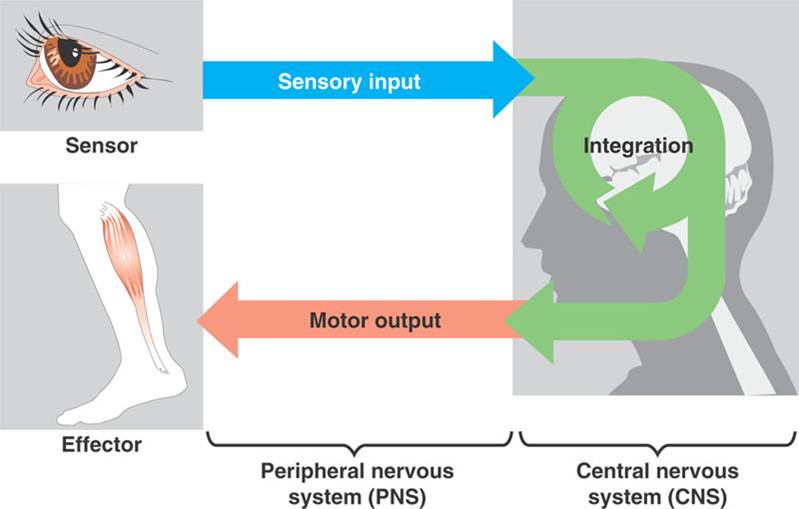Cards In This Set
| Front | Back |
|
What are the three general functions of the nervous system and which nervous system does each function?
|
 1) SENSORY INPUT -- Peripheral Nervous System 2) INTEGRATION --> Central Nervous System 3) MOTOR OUTPUT --> Peripheral Nervous System |
|
What are the 5 types of sensory receptors and what stimuli stimulate that receptor
|
Photoreceptors (Vision)
Mechanoreceptors (Touch, Hearing)
Chemoreceptors (Taste, Olfaction [smell])
Thermoreceptors (Heat, Cold)
Electroreceptors (Electric Field)
|
|
Electroreceptors are found in what type of animals? (give examples)
How does the electroreceptor work in the electric fish, include electric organ and electroreceptors in your answer!! |
Found in amphibians, platopus, fish
not in humans and most mammals Electric fish “see” in the dark by emitting weak electric signals and gathering feedback through special electroreceptors using the electric signals like a “sonar” device. They can also use electricity as a communicative device, much as humans use auditory signals. Using its electric organ, the fish produces an electric organ discharge (EOD), which is broadcast through the water and received by other fish |
|
What are accessory structures?
what are the accessory structures of the eye and what do they do? |
The function of the receptor is often strongly influenced by
Accessory Structures that are associated with the receptor
lens: focuses the light on the receptors in the retinapupil: regulates how much light gets into the eye |
|
What are the accessory structures of the ear and what do they do
|
The ear drum (aka: Tympanic Membrane) has several functions. It helps
protect our middle ear space from debris and foreign objects, it
connects to the middle ear bones (ossicles) in order to transmit
vibrations that enter the ear canal to the middle ear bones.
The ossicles are connected to the fluid-filled inner ear organ (the cochlea). The sound wave vibrations that travel through the tympanic membrane to the ossicles vibrate the inner ear fluid; which helps transmit sound to our brain. Read more: http://wiki.answers.com/Q/What_does_the_ear_drum_do_in_your_ear#ixzz1EbQTtGW3 |
|
Explain the mechanorecpetor in the Star-Nosed Mole
|
The Star-nose mole has a tactile nose that has mechanoreceptors on those tactiles
the tactiles due to the mechanoreceptor are used for the organism to feel its way through its environment the mole's tactiles are very sensitive and can distinguish particles of dirt from food |
|
Explain how crickets hear with their legs
|
crickets have a tympanic membrane on their legs
this membrane when it vibrates activates mechanorecpetors, leading to hearing |
|
Explain how bats use sonar
|
Bats yell at unltrasonic (sonar) frequencies which are reflected back off of objects in their environments
these reflected sounds are cought by the bats large ears and it can determine whether the reflected sound is a wall or a moth, for example |
|
Explain how the rattlesnake catches prey
|
- has thermoreceptor (infrared receptor)
- add |
|
Expalin how a male moth smells.
|
Male moths can detect female pheromone at a concentration of
about 100 molecules/cubic cm of air.
Some moths can track down females over a distance of several miles by
following the pheromone odor.
The antennae of the moth are covered with hairs, these hairs
are all olfactory receptors
|
|
Sensory Reception: What are the two main steps?
|
Transduction: Conversion of the stimulus energy into a
change in membrane potential (receptor potential)
Encoding: Receptor potential triggers action potentials in
the sensory neuron- Examples of Sensory Transduction Mechanisms
-Olfactory (Chemoreception)
-Audition (Mechanoreception)
-Vision (Photoreception)
|
|
What type of potential (action or graded) does a neuron have before the signal reaches the axon hillock?
does a stronger receptor potential mean higher frequencies of action potentials or does a weak receptor potential generate the higher freqency. |
Graded potential
stronger receptor potential --> higher frequency of action potentials weaker receptor potential --> lower frequency of action potentials |
|
What are the 4 steps in encoding?
|
1)Reception – stretch
receptor activated (mechanoreceptor)
2)transduction –
stimulus is transduced and a membrane potential occurs
3)Transmission –
receptor potentials trigger action potentials along
axon
4)Perception – brain
processes action potentials – more potential = larger bend
Know slide 12 |
|
Human Olfactory System: How do you smell??
|
The olfactory receptors are neurons that line the nasal
cavity. Profuse cilia project into a
mucus layer and contain G-protein coupled receptors that bind specific odors.
Axons of the receptor cells project to the brain where they synapse with cells
in the olfactory bulb.
once a receptor binds a specific odor molecule, a signal tranduction pathway is activated and the axons of the receptor cells send info to the olfactory bulb |
|
What is cilia?
|
The olfactory cilia inside the nose line the mucus membranes of the nose, remain stationary in the nose rather than wiggling around in the mucus. As smells enter the nose, they dissolve in the mucus and come into contact with the olfactory cilia. The cilia in turn transmit the smell to the olfactory nerve, which passes the information on to the brain.
|



